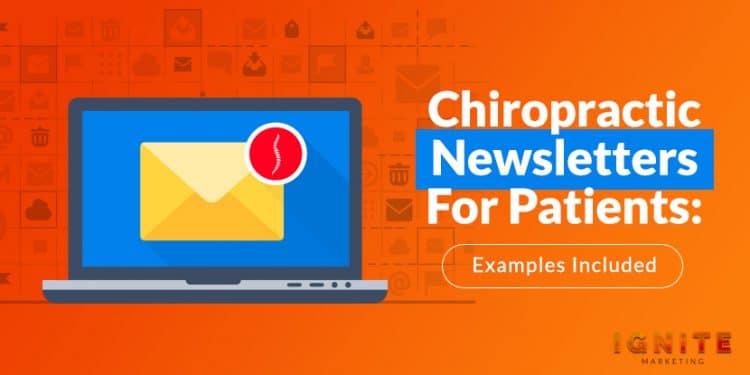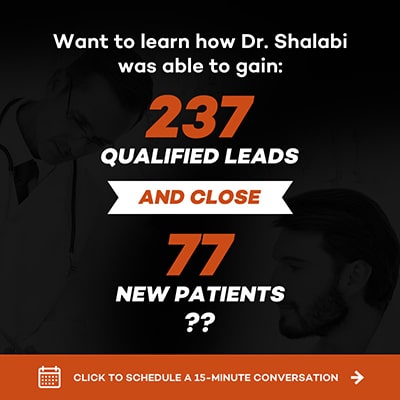


According to the DMA National Client Email Report, email marketing has an average ROI of over 3800%.
That number might seem unbelievably high ‒ but it makes sense when you think about it.
It costs nothing to send emails to people. You don't need to spend money on supplies or postage or advertisements to get your messages across. You just need some time to write an email and a list of people to send that email to.
Meanwhile, if even a fraction of the people you send that email to end up booking a chiropractic appointment because of it, you've essentially just generated money out of thin air.
And if you're a chiropractor, you're in a uniquely advantageous position when it comes to sending email newsletters.
Unless your practice is brand new, you've already got a list of people who trust you and would love to hear from you.
And as you hold an advanced degree in healthcare, any health-related advice you share will carry more weight than advice from random health blogs or other sources.
If you want to capitalize on the unique opportunities offered by starting a chiropractic newsletter, this article will tell you exactly how to do it.

Before you start typing away at the keyboard, it's important to approach the chiropractic newsletter creation process from a high-level perspective. And the best way to do that is by asking a few questions.
Many chiropractors start writing and sending newsletters because they've been told it's a good idea.
This is a fine reason to start one. After all, it is a good idea.
But if you want to derive the most value from your newsletter, you need to understand exactly why they are valuable and how they can help you grow your business.
We'll start by stating the obvious: chiropractic newsletters are created to generate more business for chiropractors. This isn't a revolutionary concept; almost everything you do in your business is done to generate revenue and increase profits.
However, it's a bit more complicated than "sending emails = making more money." Paradoxically, if you craft your newsletters for the sole purpose of increasing your income, you're probably going to make less money than if you wrote your content with other motivations in mind.
If you want to create a newsletter that brings patients in the door, your primary purpose should be helping people.
By writing email content that genuinely helps readers improve their physical and mental well-being, you will establish and strengthen a trust-based relationship with each person who reads your newsletter.
Strengthening your relationships with patients has a host of benefits, all of which will prove to be beneficial to your bottom line.

Now that you know the underlying purpose for writing a chiropractic newsletter, it's time to get into the specifics of how to create one.
Before you begin any marketing endeavor, you need to understand who your audience is and what they want from you.
Many businesses that create new products or innovative services have a hard time with this process.
Fortunately, as all chiropractors more or less offer the same services, you won't need to reinvent the wheel here. The research has already been done for you by other chiropractors and marketing experts.
If you'd like to do things by the book, you should create an audience persona to narrow down exactly who your audience is. However, I've found this to be a bit difficult to implement in the healthcare industry, mainly because people of all ages, genders, and occupations find chiropractic care useful.
We'll discuss what your audience wants in more depth later in the article. For now, here's a brief list of topics your audience will want to hear about.
The average person receives more than 95 emails a day. And as the majority of these emails are marketing emails, most will be using all kinds of copywriting tactics to stand out from the crowd and become one of the few emails that get opened each day.
You could write the most incredible, insightful email ever to grace the inboxes of your patients. But if your subject line is bland, most people won't even open it.
To help you craft a captivating subject line that draws a high email open rate, here are some essential subject line tips.
A study by Retention Science found that emails with subject lines of 6-10 words had the highest open rates. Subject lines with 1-5 words came in at a close second. So keep your subject as short and concise as possible.
That same study also found that emails containing the recipient's first name had an average open rate of 18.3%. This is a sizable improvement over the 15.7% open rate for subjects that weren't personalized.
If your email is sharing time-sensitive information about your office hours or a promotional offer, evoking a sense of urgency ("Act Now!") can increase both open rates and conversion rates. You need to be careful about this, though; adding urgency to too many email subject lines will dilute its effectiveness. Only use it when it's genuinely necessary.
People are more likely to open an email if they recognize the sender's name. If Dr. Jane Smith runs the TownVille Chiropractic Center, her email newsletter should have a sender name of "Dr. Jane Smith," not "TownVille Chiropractic Center." Doing this will also make the email feel more personal, which is another component that will help with open rates.

Using a verb at the start of your subject line will make the email seem more appealing and entice readers to click on it. "Relieve your back pain at home" is more exciting than "Back pain relief at home," as it directly tells the reader the email will be about relieving their back pain.
Including specific numbers in your subject line can make your email more intriguing to readers. You might add a number if you're providing a list of items, offering a percentage discount, or mentioning the number of days left for a promotion you're running.
Once you've got your subject line figured out, it's time to write the main content of the email.
If your email isn't relatively easy to read and digest, the majority of your readers will end up clicking out before reaching the end. As most CTAs come in at the end of the email, it's essential to make sure readers make their way to the finish line.
You also want to make your email as readable as possible for the sake of your patient relationships. If your email subscribers come to view your emails as hard to digest, they'll eventually stop opening them, even if your in-person relationship with them is superb.
There are two primary strategies you can use to make an email readable: basic vocabulary and small paragraphs.
The average internet user reads at an eighth-grade level. And even users with higher levels of vocabulary find it easier to consume text composed of short words that succinctly convey meaning.
The easiest way to measure the readability of your content is with a readability calculator. By pasting your text into one of these tools, you can learn whether your content is brief enough for the average reader.
Once you've got the vocabulary figured out, you should ensure your content is spaced out into short paragraphs. No matter how simple your vocabulary is, forcing your readers to sort through a wall of text will almost certainly kill their desire to finish reading your email.
There are no hard rules on how short you should make your paragraphs. I prefer to keep my emails at a maximum of five lines. If you go any more than that, things start to get cluttered and confusing.
Also, don't separate sentences into different paragraphs for the sake of it. Try to keep related thoughts in the same paragraph. Doing this will make it easier for the reader to organize their understanding of what you're saying and will make for a smoother reading process overall.
The ideal chiropractic email newsletter is an extension of the conversation that takes place in your office. Your patients have come to associate a certain tone and style with the way you speak ‒ so incorporate that personal feel into the emails you send them.
This advice works best if you feel comfortable writing your email newsletter yourself. But if you'd prefer to hire someone else to do it, it should still be relatively easy to imbue the writing with your communication style.
One way to do this is by writing up a rough draft of what you want to say. Once you've got your initial thoughts down on paper, you can send it to a professional copywriter and allow them to give it a nice polish. And if you truly want to make the piece your own, you can edit the copywriter's edits to ensure the email is both polished and representative of your voice.

While your email list is an excellent place to make sales pitches and announce promotional discounts on treatments, the main focus of your emails should be on helping people.
Remember, the primary goal of an email newsletter isn't to sell your chiropractic services ‒ it's to build and strengthen your relationships with your patients.
Now, those improved relationships will cause more people to come into your office on a more frequent basis. However, writing your emails with sales and conversions in mind will only make them come off as salesy and unappealing.
So even though your base motivation for writing and sending an email newsletter is to improve patient retention and increase revenue, the emails shouldn't be written with that goal in mind. Instead, think of your patients as people you care about who need your advice.
Alright, I think you get the point: write stuff that helps your patients. But what do your patients need help with?
Well, probably a lot of stuff. As a chiropractor, though, you should probably be sending tips and guides on how to relieve pain and improve health. Many patients won't be too familiar with the benefits of chiropractic care, so you can also explain how chiropractic care can improve various aspects of their life.
Here are some specific examples of newsletter topics you can cover.
Some email copywriters advocate for using an informal, almost sarcastic tone in your email body copy. A select few have even found considerable success incorporating swear words into their messages.
While this advice might work great for certain industries and brands, it's not a strategy you want to employ in your chiropractic email newsletter.
Most consumers expect healthcare practitioners to operate with a basic level of professionalism. People don't mess around when it comes to their health, and they expect their healthcare providers to have a similarly serious attitude. 
So keep your tone professional and direct. Doing so will show you're serious about your profession and your work, which is the underlying message you want to send to your patients.
That isn't to say you can't inject some personality into the email copy. Bland text that reads like it's coming straight from a medical textbook is probably the worst thing you could put into your email. Just make sure you don't go overboard and undermine the value of the content you're sending out.
I've said this before, and I'll say it again: it's vitally important that your email reads like a continuation of the patient-doctor conversation that started in your office.
When you treat patients, you don't treat them 50 at a time. You have one-on-one interactions with each person that visits your office. So continue that trend in your email newsletter.
Sure, you might be sending the same message at the same time to hundreds or thousands of people. You're not really addressing everyone at the same time, though. Each person who opens your email will be doing so in their own inbox at a time of their choosing. As such, an email newsletter is really like thousands of one-on-one conversations that happen to say the same thing.
Okay, so what actionable advice can you take from this?
It's simple: when you're writing your body copy, write like you're talking directly to another person.
Use words like "you" to indicate you're talking directly to the reader. I find it helpful to literally speak out loud to an imaginary person in the room and then transcribe what I say onto a text document.
Don't use phrases like "you all" or "everyone reading this," as these will remind the reader that they are one of many people receiving this exact email. By keeping your message personalized and conversation-oriented, you can craft a more engaging email and drive more patients through your office doors.

While the majority of the emails you send won't be written with conversions in mind, it's still smart to end your emails with a call to action.
Most of the informative content you share with your audience will be about how chiropractic care can help them. So while you might not be spamming people with salesy promotional messages, some of your readers will be interested in getting treatment by the time they finish reading one of your emails.
To encourage them to come into your office for a visit, you should include a strong and direct call to action at the end of your email.
While you might be hesitant to do this, it really is essential if you want your email newsletter to result in more patient visits. Most people who view any kind of marketing content will not take an action unless you specifically ask them to do so. And yes, your email newsletter is marketing content, even if it doesn't read like it.
Here are a few tips for creating a compelling call to action.
One obstacle many healthcare professionals struggle with is keeping their email communications HIPAA-compliant. HIPAA's rules about email can be a bit vague and intimidating, so I'm going to lay out the do's and don'ts of compliant chiropractic email marketing.
Necessary disclaimer: I am not a lawyer, and nothing I say should be taken as legal advice. If you want legal advice regarding HIPAA compliance, please contact an attorney.
Even if you have a list of patient emails that you gathered from their intake forms, you can't use those for marketing purposes unless you specifically asked patients if it was okay to send them promotional content.
While you can technically get oral consent from patients, it's a good idea to get permission in writing. That way, there's no ambiguity if you get audited and need to provide proof that you got the okay to send patients marketing emails.
The easiest way to obtain permission is by adding a checkbox on your patient intake form that asks if it's okay to send marketing content to the patient's email address.
To use a list of patient emails for email marketing purposes, you need to share that list with a third-party email marketing service provider. And according to HIPAA, any third party you share patient information with needs to enter into a Business Associate Agreement (BAA) with you.
If your service provider doesn't sign a BAA, you're technically violating HIPAA by sharing your email list with them. To avoid this potentially costly problem, ensure your provider will enter into a BAA before signing up with them.
To make things simple, here is a list of HIPAA-compliant email marketing service providers:
To finish off the article, here are some example chiropractic newsletters that you can draw inspiration from.
Starting an email newsletter is an excellent way for chiropractors to connect with patients and improve customer retention rates.
However, your email marketing efforts will only be successful if they're crafted with the right goals in mind.
If the primary focus of your emails is getting as many patients in the door as possible, you're not going to be happy with the results.
But if you send emails with the goal of helping your subscribers in mind, you can simultaneously provide patients with beneficial information and generate additional revenue for your business.
